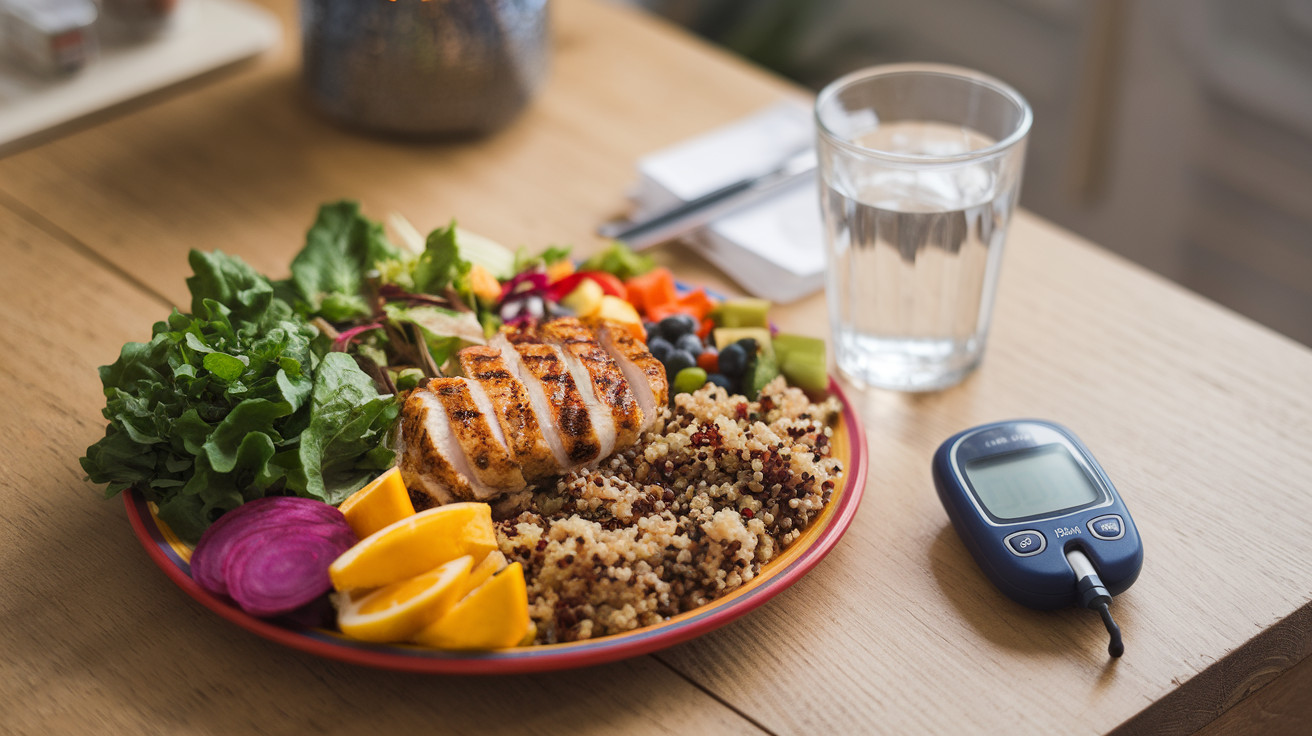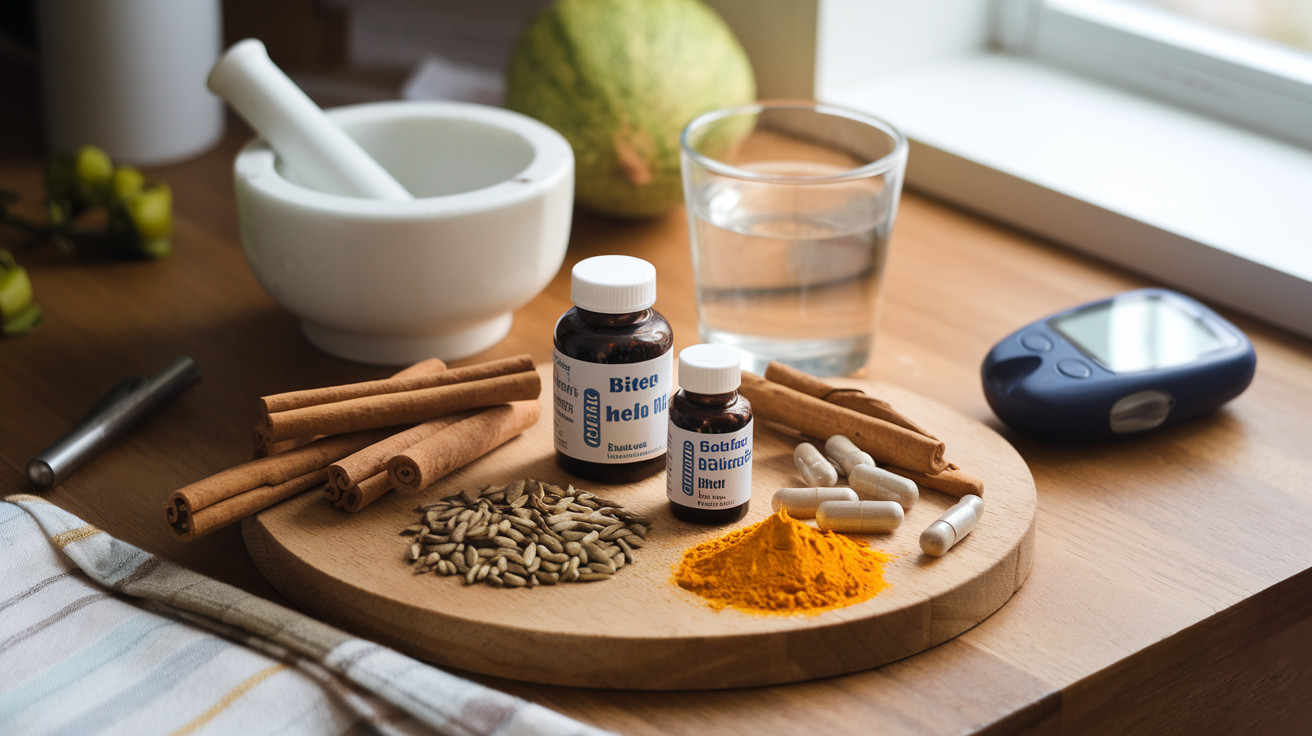Last Updated on October 12, 2024 by Alexander Sennuga
Success to lower A1C naturally is achievable, and not rocket science.
Are you tired of feeling like your blood sugar is on a rollercoaster ride? If you’re one of the millions grappling with high A1C levels, you’re not alone. But here’s the good news: you have the power to take control of your health, and it doesn’t always require drastic measures or complicated medical interventions.
Imagine waking up each day feeling energized, knowing that you’re actively reducing your risk of diabetes-related complications. It’s not just a dream – it’s entirely possible through natural methods that fit seamlessly into your daily life. From simple dietary tweaks to stress-busting techniques, lowering your A1C can be both effective and enjoyable.
In this comprehensive guide, we’ll explore 9 key areas that can help you naturally lower your A1C levels. Whether you’re looking to make small changes or overhaul your lifestyle, you’ll find actionable tips and inspiring success stories to guide you on your journey to better health. So, are you ready to take the first step towards a healthier, happier you?
Let’s dive in and discover how you can become the master of your A1C!
Understanding A1C and Its Importance

What is A1C?
A1C, also known as HbA1c or glycated hemoglobin, is a crucial measure of average blood sugar levels over the past 2-3 months. This test provides a comprehensive view of long-term blood glucose control, making it an essential tool for diagnosing and managing diabetes.
The A1C test works by measuring the percentage of hemoglobin proteins in red blood cells that have glucose attached to them. As glucose circulates in the bloodstream, it naturally binds to hemoglobin. The higher the blood glucose levels, the more glucose attaches to hemoglobin, resulting in a higher A1C percentage.
Normal vs. Elevated A1C Levels
Understanding A1C levels is crucial for effective diabetes management. Here’s a breakdown of A1C ranges and their interpretations:
| A1C Range | Interpretation |
|---|---|
| Below 5.7% | Normal |
| 5.7% – 6.4% | Prediabetes |
| 6.5% or above | Diabetes |
For individuals with diagnosed diabetes, the target A1C level is typically below 7%. However, this target may vary based on individual factors such as age, overall health, and the presence of other medical conditions.
Health Risks of High A1C
Elevated A1C levels pose significant health risks, particularly when left unmanaged over extended periods. Some of the primary concerns associated with high A1C include:
- Cardiovascular complications:
- Increased risk of heart disease
- Higher likelihood of stroke
- Development of peripheral artery disease
- Kidney damage:
- Diabetic nephropathy
- Potential progression to kidney failure
- Nerve damage (neuropathy):
- Peripheral neuropathy affecting hands and feet
- Autonomic neuropathy impacting the digestive and cardiovascular systems
- Vision problems:
- Diabetic retinopathy
- Increased risk of cataracts and glaucoma
- Slow wound healing:
- Higher susceptibility to infections
- Increased risk of foot ulcers and amputations
Understanding these risks underscores the importance of maintaining optimal A1C levels through proper diabetes management.
By keeping A1C within the target range, individuals can significantly reduce their risk of developing these serious complications and improve their overall quality of life.
Now that we have a clear understanding of A1C and its importance, let’s explore effective dietary changes that can help lower A1C levels naturally.
Dietary Changes for Lowering A1C

Now that we understand the importance of A1C in managing diabetes, let’s explore how dietary changes can significantly impact your A1C levels. By making smart food choices and adopting healthy eating habits, you can naturally lower your A1C and improve your overall health.
Embracing Low-Glycemic Foods
Low-glycemic foods are crucial in managing blood sugar levels and lowering A1C. These foods release glucose slowly into the bloodstream, preventing sudden spikes in blood sugar. Here’s a list of low-glycemic foods to incorporate into your diet:
- Non-starchy vegetables (leafy greens, broccoli, cauliflower)
- Whole grains (quinoa, barley, oats)
- Lean proteins (chicken, fish, tofu)
- Legumes (lentils, chickpeas, beans)
- Nuts and seeds
Increasing Fiber Intake
Fiber plays a vital role in blood sugar management and A1C reduction. It slows down digestion and helps regulate glucose absorption. Aim to include both soluble and insoluble fiber in your diet. Here’s a table comparing fiber content in common foods:
| Food | Fiber Content (per 100g) |
|---|---|
| Chia seeds | 34g |
| Almonds | 12.5g |
| Lentils | 7.9g |
| Raspberries | 6.5g |
| Broccoli | 2.6g |
Portion Control Strategies
Controlling portion sizes is essential for managing blood sugar levels and lowering A1C. Here are some effective strategies:
- Use smaller plates to create the illusion of a full meal
- Practice the plate method: 1/2 plate non-starchy vegetables, 1/4 plate lean protein, 1/4 plate complex carbohydrates
- Use measuring cups or a food scale to accurately portion foods
- Be mindful of high-calorie condiments and dressings
Hydration’s Role in Blood Sugar Management
Proper hydration is often overlooked but plays a crucial role in managing blood sugar levels and lowering A1C. Water helps flush out excess glucose through urine and prevents dehydration, which can concentrate blood sugar. Here are some tips for staying hydrated:
- Aim for at least 8 glasses of water per day
- Choose water over sugary drinks
- Infuse water with fruits or herbs for added flavor
- Monitor urine color (pale yellow indicates good hydration)
By implementing these dietary changes, you can significantly impact your A1C levels and improve your overall diabetes management. Remember, consistency is key, and it’s essential to work with your healthcare provider to develop a personalized plan that suits your specific needs and health goals. Next, we’ll explore how incorporating regular exercise can further contribute to lowering your A1C naturally.
Exercise Routines to Reduce A1C

Now that we’ve explored dietary changes, let’s focus on another crucial aspect of lowering A1C naturally: exercise routines. Regular physical activity plays a significant role in managing blood sugar levels and improving overall health for individuals with diabetes.
Benefits of Regular Physical Activity
Regular exercise offers numerous benefits for those looking to lower their A1C levels:
- Improved insulin sensitivity
- Enhanced glucose uptake by muscle cells
- Reduced body fat percentage
- Lower risk of cardiovascular complications
- Increased energy levels and mood improvement
Aerobic Exercises for Blood Sugar Control
Aerobic exercises, also known as cardio, are excellent for managing blood sugar levels. Here are some effective options:
- Brisk walking
- Cycling
- Swimming
- Dancing
- Jogging or running
Aim for at least 150 minutes of moderate-intensity aerobic activity per week, spread across multiple sessions. This can help improve your body’s ability to use insulin and lower A1C levels over time.
Strength Training’s Impact on Insulin Sensitivity
Incorporating strength training into your routine can significantly enhance insulin sensitivity. Here’s how it helps:
- Builds lean muscle mass
- Increases metabolic rate
- Improves glucose storage in muscles
Try to include strength training exercises at least twice a week, targeting all major muscle groups. Here’s a simple routine to get started:
| Exercise | Sets | Repetitions |
|---|---|---|
| Squats | 3 | 10-12 |
| Push-ups | 3 | 8-10 |
| Lunges | 3 | 10 per leg |
| Planks | 3 | 30 seconds |
| Rows | 3 | 10-12 |
Creating a Sustainable Workout Plan
To effectively lower A1C levels through exercise, it’s crucial to develop a sustainable workout plan. Consider the following tips:
- Start slowly and gradually increase the intensity
- Choose activities you enjoy to maintain motivation
- Mix different types of exercises for a variety
- Set realistic goals and track your progress
- Listen to your body and adjust as needed
Remember to consult with your healthcare provider before starting any new exercise routine, especially if you have existing health conditions or complications related to diabetes.
By incorporating regular physical activity into your lifestyle, you can significantly improve your A1C levels and overall health. Next, we’ll explore stress management techniques that can further support your efforts in naturally lowering A1C.
Stress Management Techniques

Now that we’ve explored exercise routines for reducing A1C, let’s delve into the crucial role of stress management in controlling blood sugar levels. Stress can significantly impact your A1C levels, making it essential to incorporate effective stress management techniques into your daily routine.
The link between stress and blood sugar
Stress and blood sugar levels are intricately connected. When you experience stress, your body releases hormones like cortisol and adrenaline, which can cause your blood sugar to spike. This stress-induced elevation in blood glucose can contribute to higher A1C levels over time.
| Stress Response | Effect on Blood Sugar |
|---|---|
| Cortisol release | Increases glucose production |
| Adrenaline surge | Reduces insulin sensitivity |
| Chronic stress | Persistent high blood sugar |
Understanding this connection emphasizes the importance of managing stress as part of your overall strategy to lower A1C naturally.
Mindfulness and meditation practices
Incorporating mindfulness and meditation into your daily routine can significantly reduce stress levels and, in turn, help manage your blood sugar. These practices can:
- Decrease cortisol levels
- Improve insulin sensitivity
- Enhance overall well-being
Try starting with just 5-10 minutes of mindfulness or meditation daily, gradually increasing the duration as you become more comfortable with the practice.
Deep breathing exercises
Deep breathing exercises are simple yet powerful tools for managing stress and potentially lowering A1C levels. These exercises can:
- Activate the parasympathetic nervous system
- Reduce cortisol levels
- Improve oxygen flow throughout the body
One effective technique is the 4-7-8 breathing method:
- Inhale through your nose for 4 seconds
- Hold your breath for 7 seconds
- Exhale slowly through your mouth for 8 seconds
- Repeat 4-5 times
Practicing this technique regularly can help you manage stress and potentially contribute to better blood sugar control.
Importance of quality sleep
Quality sleep plays a crucial role in stress management and blood sugar control. Poor sleep can lead to increased stress levels and insulin resistance, both of which can negatively impact your A1C levels.
To improve your sleep quality:
- Maintain a consistent sleep schedule
- Create a relaxing bedtime routine
- Limit screen time before bed
- Ensure your sleeping environment is comfortable and dark
By prioritizing good sleep hygiene, you can help manage stress levels and potentially improve your A1C readings.
Incorporating these stress management techniques into your daily routine can significantly contribute to your efforts in lowering A1C naturally. As we move forward, we’ll explore natural supplements and herbs that can further support your journey towards better blood sugar control.
Natural Supplements and Herbs

Now that we’ve explored lifestyle modifications, let’s delve into the world of natural supplements and herbs that may help lower A1C levels. While these options can be beneficial, it’s crucial to approach them with caution and under professional guidance.
Cinnamon’s Potential Benefits
Cinnamon has garnered attention for its potential to improve insulin sensitivity and lower blood sugar levels. This common spice contains compounds that may mimic insulin and increase glucose uptake by cells.
- Studies suggest 1-6 grams of cinnamon per day may reduce fasting blood glucose.
- Cinnamon may also help lower cholesterol levels
- Available in various forms: powder, capsules, or essential oil
Berberine as a Natural Alternative
Berberine, a compound found in several plants, has shown promising results in managing blood sugar levels. Its effectiveness is often compared to that of metformin, a common diabetes medication.
- May improve insulin sensitivity and reduce glucose production in the liver
- Typical dosage ranges from 900-1500 mg per day, divided into 2-3 doses
- Can interact with certain medications, so consultation with a healthcare provider is essential
Alpha-lipoic Acid for Glucose Control
Alpha-lipoic acid (ALA) is a powerful antioxidant that may help improve insulin sensitivity and reduce A1C levels.
- Acts as both a fat and water-soluble antioxidant
- May help reduce nerve pain associated with diabetes
- Typical dosage ranges from 300-1200 mg per day
Here’s a comparison of these supplements:
| Supplement | Main Benefit | Typical Daily Dosage | Potential Side Effects |
|---|---|---|---|
| Cinnamon | Improves insulin sensitivity | 1-6 grams | Liver damage (in high doses) |
| Berberine | Lowers blood glucose | 900-1500 mg | Digestive issues |
| Alpha-lipoic Acid | Improves insulin sensitivity | 300-1200 mg | Skin rash, nausea |
Consulting with Healthcare Providers Before Supplementation
While natural supplements can be beneficial, they’re not without risks. It’s crucial to consult with healthcare providers before starting any new supplement regimen.
- Supplements can interact with medications or affect existing health conditions.
- A healthcare provider can help determine appropriate dosages and monitor for side effects.
- They can also assess whether supplements are necessary or if dietary changes would be more beneficial.
Remember, supplements should complement, not replace, a healthy diet and lifestyle. Always prioritize a balanced diet, regular exercise, and stress management in your efforts to lower A1C levels naturally.
Next, we’ll explore some inspiring success stories and testimonies from individuals who have successfully lowered their A1C levels using these natural methods.
Lifestyle Modifications for Long-term A1C Control

Now that we’ve explored various strategies to lower A1C naturally, let’s focus on essential lifestyle modifications that can help you maintain long-term control over your blood sugar levels. These changes, when incorporated consistently into your daily routine, can significantly impact your A1C levels and overall health.
Establishing Consistent Meal Times
One of the most effective ways to manage your A1C levels is by maintaining a regular eating schedule. Consistent meal times help regulate your body’s insulin production and glucose utilization. Here’s a simple guideline to follow:
- Eat three main meals at roughly the same time each day
- Include 1-2 small, healthy snacks between meals if needed
- Aim for a 12-hour overnight fast
By following this pattern, you can help stabilize your blood sugar levels throughout the day and night.
Monitoring Blood Sugar Regularly
Regular blood sugar monitoring is crucial for long-term A1C control. It allows you to:
- Understand how different foods affect your glucose levels
- Identify patterns and trends in your blood sugar
- Make informed decisions about your diet and medication
Here’s a recommended monitoring schedule:
| Time of Day | Frequency |
|---|---|
| Before meals | 2-3 times daily |
| 2 hours after meals | 2-3 times daily |
| Before bedtime | Daily |
| Occasionally at night | 1-2 times weekly |
Avoiding Smoking and Excessive Alcohol Consumption
Both smoking and excessive alcohol consumption can negatively impact your A1C levels and overall health. Here’s why:
- Smoking increases insulin resistance and inflammation
- Alcohol can cause unpredictable fluctuations in blood sugar levels
To improve your A1C control:
- Quit smoking or seek support to do so
- Limit alcohol consumption to no more than one drink per day for women and two for men
- Always consume alcohol with food to minimize blood sugar spikes
Building a Support Network
Managing diabetes and lowering A1C levels can be challenging, but you don’t have to do it alone. A strong support network can provide:
- Emotional support and encouragement
- Practical assistance with meal planning and exercise
- Accountability for your health goals
Consider these options for building your support network:
- Join a local or online diabetes support group
- Involve family and friends in your health journey
- Work with a diabetes educator or nutritionist
- Participate in community health programs focused on diabetes management
By implementing these lifestyle modifications, you’ll be well on your way to achieving long-term A1C control. Remember, consistency is key, and small changes can lead to significant improvements in your overall health and well-being. In the next section, we’ll explore some inspiring success stories and testimonies from individuals who have successfully lowered their A1C levels naturally.
Success Stories and Testimonies
Examples of Individuals Who Successfully Lowered A1C Naturally
Lowering A1C naturally is not just a theory; it’s a reality for many individuals who have taken charge of their health. Let’s explore some inspiring success stories that demonstrate the power of natural A1C reduction methods.
- Sarah’s Journey: From 8.2% to 5.9%
- Initial A1C: 8.2%
- Final A1C: 5.9%
- Time frame: 6 months
- Key strategies:
- Adopted a low-carb, high-fiber diet
- Incorporated 30 minutes of daily walking
- Practiced meditation for stress management
- Mike’s Transformation: 9.1% to 6.5%
- Initial A1C: 9.1%
- Final A1C: 6.5%
- Time frame: 9 months
- Key strategies:
- Switched to a plant-based diet
- Joined a local gym and exercised 5 days a week
- Used cinnamon supplements daily
- Lisa’s Success: 7.8% to 6.1%
- Initial A1C: 7.8%
- Final A1C: 6.1%
- Time frame: 4 months
- Key strategies:
- Followed intermittent fasting
- Practiced yoga and meditation
- Incorporated berberine supplements
Insights and Tips from Their Journeys
These success stories offer valuable insights for others looking to lower their A1C naturally. Here are some key takeaways:
- Consistency is key: All three individuals maintained their new habits consistently over several months.
- Personalization matters: Each person found a combination of strategies that worked best for their lifestyle and preferences.
- Holistic approach: Successful A1C reduction often involves a combination of diet, exercise, and stress management techniques.
| Strategy | Sarah | Mike | Lisa |
|---|---|---|---|
| Diet Changes | ✓ | ✓ | ✓ |
| Regular Exercise | ✓ | ✓ | ✓ |
| Stress Management | ✓ | – | ✓ |
| Supplements | – | ✓ | ✓ |
Additional tips from these success stories include:
- Start small and gradually increase intensity: Sarah began with short walks and progressively increased her activity level.
- Find enjoyable activities: Mike discovered his love for gym workouts, making exercise a sustainable habit.
- Experiment with different approaches: Lisa tried intermittent fasting and found it effective for her body.
- Seek support: All three individuals mentioned the importance of family and community support in their journey.
- Regular monitoring: Frequent A1C checks helped them stay motivated and adjust their strategies as needed.
These real-life examples demonstrate that lowering A1C naturally is achievable with dedication, the right strategies, and a personalized approach. They serve as inspiration for others embarking on their journey to better health and diabetes management.
Myths and Misconceptions

As we delve into the topic of lowering A1C naturally, it’s crucial to address some common myths and misconceptions that often circulate. By clarifying these misunderstandings, we can ensure that you have accurate, evidence-based information to guide your diabetes management journey.
Common myths about natural A1C management methods
- Myth: You can’t lower A1C naturally without medication
This is one of the most pervasive myths about A1C management. While medication can be an important part of diabetes treatment, lifestyle changes can significantly impact A1C levels. - Myth: All carbohydrates are bad for people with diabetes
Carbohydrates aren’t the enemy. The key is choosing complex carbohydrates and managing portion sizes. - Myth: Natural supplements can replace conventional diabetes treatment
While some supplements may have benefits, they should complement, not replace, medical advice and treatment. - Myth: Exercise is dangerous for people with diabetes
Regular physical activity is beneficial for managing blood sugar levels and lowering A1C. - Myth: Stress doesn’t affect blood sugar levels
Stress can have a significant impact on blood sugar control and A1C levels.
Clarifications and evidence-based information
Let’s address these myths with factual information:
- Natural A1C reduction is possible
Research shows that lifestyle changes can significantly lower A1C. A study published in the New England Journal of Medicine found that intensive lifestyle interventions reduced A1C by an average of 0.6% over three years. - Carbohydrate quality matters
Not all carbs are created equal. Here’s a comparison of good vs. bad carbohydrate sources:Good Carbs Bad Carbs Whole grains Refined grains Legumes Sugary snacks Fruits Sweetened beverages Vegetables Processed foods - Supplements are complimentary
While some natural supplements like cinnamon and berberine have shown promise in supporting blood sugar control, they should be used alongside, not instead, conventional treatments. Always consult your healthcare provider before starting any supplement regimen. - Exercise is beneficial
Regular physical activity can lower A1C by improving insulin sensitivity. The American Diabetes Association recommends at least 150 minutes of moderate-intensity aerobic activity per week for adults with diabetes. - Stress management is crucial.
Stress hormones can raise blood sugar levels. Techniques like meditation, yoga, and deep breathing can help manage stress and, in turn, support better blood sugar control.
By understanding these facts, you can make informed decisions about your diabetes management strategy. Remember, while natural methods can be effective in lowering A1C, it’s essential to work closely with your healthcare team to develop a comprehensive plan that’s tailored to your individual needs. Next, we’ll explore some valuable resources and further reading to deepen your understanding of managing your A1C levels naturally.
Resources and Further Reading
As you continue your journey to lower your A1C naturally, it’s essential to have access to reliable information and support. This section provides a comprehensive list of resources to deepen your understanding and guide you toward effective diabetes management.
Recommended Books, Websites, and Community Resources
To help you on your path to lowering A1C naturally, we’ve compiled a list of valuable resources:
- Books:
- “The Diabetes Code” by Dr. Jason Fung
- “Diabetes Solution” by Dr. Richard K. Bernstein
- “The Complete Guide to Fasting” by Dr. Jason Fung and Jimmy Moore
- Websites:
- American Diabetes Association (www.diabetes.org)
- Diabetes Self-Management (www.diabetesselfmanagement.com)
- Diabetes Daily (www.diabetesdaily.com)
- Community Resources:
- Local diabetes support groups
- Online forums like DiabetesForum.com
- Diabetes education classes at local hospitals or clinics
Links to Studies and Expert Articles for In-depth Understanding
For those seeking more scientific information on A1C reduction and diabetes management, here are some reputable sources:
| Source | Description | Link |
|---|---|---|
| National Institute of Diabetes and Digestive and Kidney Diseases | Comprehensive overview of A1C tests | NIDDK A1C Test |
| American Diabetes Association | Guidelines for glycemic targets | ADA Standards of Care |
| Diabetes Care Journal | Study on lifestyle interventions for A1C reduction | Lifestyle Interventions for A1C Reduction |
These resources provide a wealth of information to support your efforts in lowering A1C naturally. From practical tips to scientific studies, you’ll find valuable insights to help you manage your diabetes effectively.
Remember, while self-education is important, always consult with your healthcare provider before making significant changes to your diabetes management plan.
As you explore these resources, you’ll be better equipped to implement the strategies discussed in previous sections, from dietary changes to stress management techniques.
The journey to lower A1C is ongoing, but with the right information and support, you can achieve and maintain healthy blood sugar levels naturally.
Lowering your A1C naturally is an achievable goal with the right approach. You can significantly impact your blood sugar levels by making dietary changes, incorporating regular exercise, managing stress, and considering natural supplements.
Lifestyle modifications, such as improving sleep quality and staying hydrated, play a crucial role in long-term A1C control.
For more in-depth information, check out this guide on managing diabetes from the American Diabetes Association.
Remember, everyone’s journey to better health is unique. Consult your healthcare provider before making significant changes to your routine, especially if you’re taking medications. With patience, persistence, and the right strategies, you can take control of your A1C levels and improve your overall health. Start small, stay consistent, and celebrate your progress to a healthier you.
Conclusion
Setting of goals to lower A1C naturally is an achievable goal with the right approach. You can significantly impact your blood sugar levels by making dietary changes, incorporating regular exercise, managing stress, and considering natural supplements.
Lifestyle modifications, such as improving sleep quality and staying hydrated, play a crucial role in long-term A1C control.
Remember, everyone’s journey to better health is unique. Consult your healthcare provider before making significant changes to your routine, especially if you’re taking medications. With patience, persistence, and the right strategies, you can take control of your A1C levels and improve your overall health.
Start small, stay consistent, and celebrate your progress to a healthier you.

